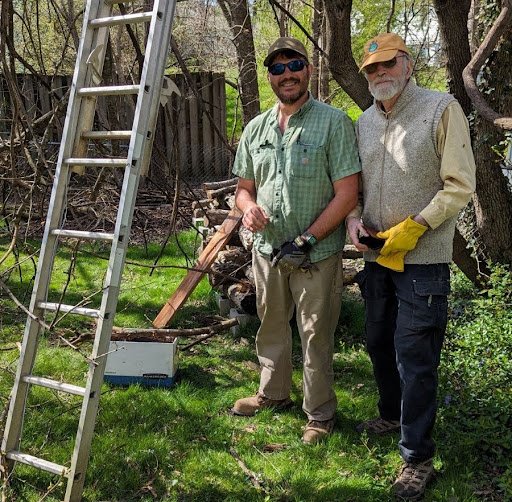A Spring Story of Death and Rebirth
This is a photo of our apiary last May. We were able to winter over four colonies and caught one swarm for a total of five individual hives. The timing of the swarm allowed us to invite it into a hive box during Farm Friday where many of you were able to watch the bees go into their new home.
Unfortunately, out of this abundance, all of our colonies perished by March this year. Clover hive who had been with us four years, perished over the summer from a bacterial disease that affects the developing larva. Sage Hive, two years old, perished in the Autumn when something happened to her queen, and they were not able to raise another queen in time. Calendula hive, the new swarm, also perished in the autumn. That left Salvia, three years old, and Freesia, also three years old. Freesia perished through freezing in her winter cluster not having enough bees to stay warm, which I discovered at the beginning of February. Salvia was still alive as a small cluster at this time, but by March 15th she was gone, leaving six frames of honeycomb.
Honeybees are challenged by multiple environmental factors that a loving human community can be very helpful with. Unfortunately due to the extra needs in the kindergarten afternoon program, I was not able to serve the honeybees in the Autumn as much as I usually do. We will be working this spring to develop a working community group to help support the bees this spring, over the summer, and into the autumn next year. For the love of the honeybees! Bee on the lookout for more information in the next newsletter.
Sunday March 17th
As good fortune raises the heart’s smile in times of sadness, we had a swarm of bees fly out of one of our home hives while my husband and I were eating lunch and looking out at the garden! As some of you may know, swarming is the natural way that honeybees healthfully diversify and multiply, choosing their own genetics for future generations. (In the bee business, this natural process is suppressed and replaced by artificially inseminated genetically engineered queens.)
The bees collected on a branch of a high tree behind our two hives.
Can you see the bundle of bees up at the top of the photo?
Monday March 18
Mark and I were unable to gather them on that day because of the height, but the next day, Ian generously came over with the rope saw to work with Mark to bring the branch down so we could place them in a resting travel box.
It wasn’t a clean catch when the branch came down. Some bees fell on the tarp with the box, but the main branch came down in the grass. Note the bundle of bees in the grass.
This was the most arduous swarm gathering I have experienced in my five years working with swarms. It is a little like being a midwife. When the call comes, it’s time to go!
We had to cut three different branches as the bees kept flying back up into the tree. Over the course of 2 ½ hours, we were able to scoop the bees into the open box and then finally the queen. We were only able to find the queen after I asked for help from the bees to find her. I turned around and she was in a little bundle of bees on the bottom side of the table behind me. I carried her to the box, and the bees settled into their travel box. We closed the small door when they were all inside.
Meanwhile, back at the Farm, Farmer Kristin was leveling a spot for the new stump to hold the hive. Our generous Neighbor, who cleared some trees from his property by the high school, donated some good-sized stumps to our Apiary.
Tuesday March 19th. The First Day of Spring!
The next afternoon, the box traveled to the farm. Ian, our Facilities Manager, and Julio, our campus cleaner, helped to move and level the stump. We invited the swarm into a hive box at the farm as the sun descended into the evening at 5 pm. This is a time that encourages the bees to settle in rather than fly away. Two sixth-grade families and Julio joined the festivities.
The bees hold hands and cling to the lid.
I give a firm shake so they drop onto the ramp on an incline to the hive entrance.
We watched as they marched into the hive! We got to see the Queen, a beautiful dark amber, wind her way inside. We gave those six medium frames of honeycomb from Salvia to the new swarm for a good start of their new life. The bees can make new wax on the deep box of empty frames by ingesting honey.
Thank you Jack and Lyle in sixth grade, and their Moms, Theresa and Rebecca, as well as Julio for joining the celebration of honeybees restored to our Emerson Farm Apiary!
This swarm came from the colony at my home, which we received from Spikenard Farm and Honeybee Sanctuary last spring, where I participated in the biodynamic beekeepers’ training. We named her Faina, which is a Slovich female name meaning shining or brilliant. So Faina is the mother hive, Frannie is her grandmother hive and Friskie is her Great Grandmother hive at Spikenard! She comes from a long line of naturally raised Queens. We were looking for an “F” name for her, as is the tradition, and since she swarmed on St. Patrick’s Day, we thought a good Irish name would be appropriate. Fiona.
Welcome Fiona Hive to Emerson Farm Apiary!
Please feel free to come visit the honeybees. Watching from the side is best. And please help children from walking in front where the bees have their flyway. They are great fun to watch in their loving service to the world. You may even see the drones this time of year, who have no stingers. They visit all the hives in the community and share intel, like the traveling minstrels of old.
In the Honeybee’s circle of Love,
Andrea Eichinger-Wiese
EWS Honeybee Caretaker
Goldfinch Kindergarten Teacher
Thank you for the photos from Ian Ostrowski, Mark EW, Theresa Menz, and Rebecca Berenfield.











